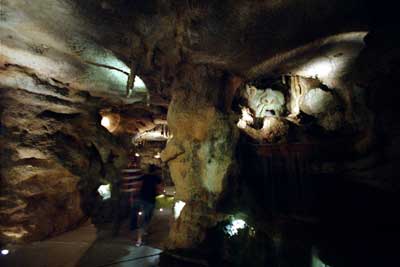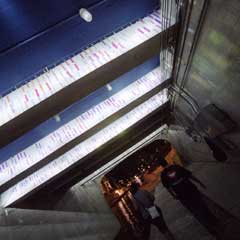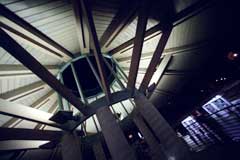

Placemaking at its best
(page 2 of 2)


Above: 'Rock formation' towers above
grotto by Carlos Cortés. Right:
Cove lighting makes night-time passage through the grotto especially
intriguing.
The Urban Segment’s magnetic countermeasures along this two-block stretch might almost be faulted as overkill -- the spectacular grotto by local concrete artist Carlos Cortés, its towering “rock formation” drawing attention from nearby streets; the less-noticed but superbly conceived and crafted faux-bois Palapa by Cortés at the corner of Camden and Newell; a stone-bordered pond demonstrating riparian ecology just below the freeway; the steel
 footbridge,
formerly connecting the two towers of
the nearby brewery that became the San Antonio Museum of Art, at
Roy Smith Street; and Lipski’s “F.I.S.H.” hanging under the I-35
bridge itself. Oh, and the bats. They were already there, but now their
evening forays are easily accesible to public view.
footbridge,
formerly connecting the two towers of
the nearby brewery that became the San Antonio Museum of Art, at
Roy Smith Street; and Lipski’s “F.I.S.H.” hanging under the I-35
bridge itself. Oh, and the bats. They were already there, but now their
evening forays are easily accesible to public view.The bridge that had seemed a barrier has become a gateway. The view downstream -- framed by the overpass, terminated by the art museum and briefly each evening animated by the awakening bats -- is one of the most dramatic in the city.
The Cortés and Lipski works are the most prominent pieces from a highly ambitious public art program funded by the San Antonio River Foundation. Other works enhanced the passages under several surface-street bridges. Bill Fontana’s soundscape at Jones Avenue bridge and Martin Richman’s magical “Shimmer Field” at Lexington are particularly fetching. Still to come are railings for the Camden and Newell bridges by George Schroeder and shade structures for the McCullough Avenue, Brooklyn Street and Ninth Street bridges by Rolando Briseño.
Also contributing to the project’s fit and finish are first-class stonework by Krisch Construction and excellent environmental graphics -- wayfinding kiosks, wall-mounted metal location signs and interpretive panels -- by Juliana Marek-Hill of Houston.


The interpretive panels, with texts by the indispenable local historian-of-place Maria Watson Pfeiffer, give the Urban Segment a valuable educational aspect. Panels along the walkways inform visitors about the work of Hugman, a stone footing from an old mill dam (at night, the footprint of the vanished dam itself is neatly outlined in submerged lights), riparian ecology, and the artesian wells that watered the local brewing industry.
Rather than hide or gussy up a large vent for the flood-control tunnel, the design team put it on proud display, with an interpretive panel explaining the tunnel system.
The one cause for regret in the Urban Reach is the loss of the natural river environment. The design team has tried to recall some of that environment with several artificial marshes and ponds, sequestered from the main channel and planted with water lilies and rushes. The water for these features (as for the grotto’s waterfall) comes from the river itself, either by pump or (for the marsh at the turning basin behind Pearl) by aqueduct, and the plant life is expected to filter and clean the water before it returns to the main channel. Once the aquatic plantings mature, passages through these areas should be among the most delightful of the Urban Segment.
A portion of the original Hugman dam (left, with interpretive sign) was removed to allow barge traffic, but in compensation the designers of the Urban Segment created a new dam (below), wider and splashier than Hugman's, next to the Pearl Brewery redevelopment at Grayson Street.


Modernist
regional-vernacular gazebo is one of several shade structures
overlooking the river along the Urban Segment.
Some visitors have faulted the walkways for being too narrow in places to comfortably accommodate both a person in a wheelchair and one on foot. The absence of a public walkway behind the art museum is lamentable, but the Roy Smith Street pedestrian bridge, with its new masonry portals echoing architectural details from the nearby art museum, turned out to be a felicitous workaround.
The negatives are remarkably few for a project of this magnitude, and with so many features that could have misfired.
Although the designers of the Urban Segment spoke Hugman’s language with native fluency, they also understood that the essence of his vision was not his style or vocabulary, but his sense of theater and movement, of something always pulling the visitor forward and around the bend. Combined with great attention to detail, excellent craftsmanship and a first-rate public art program, that sense of theater has given San Antonio a new example of placemaking at its best.